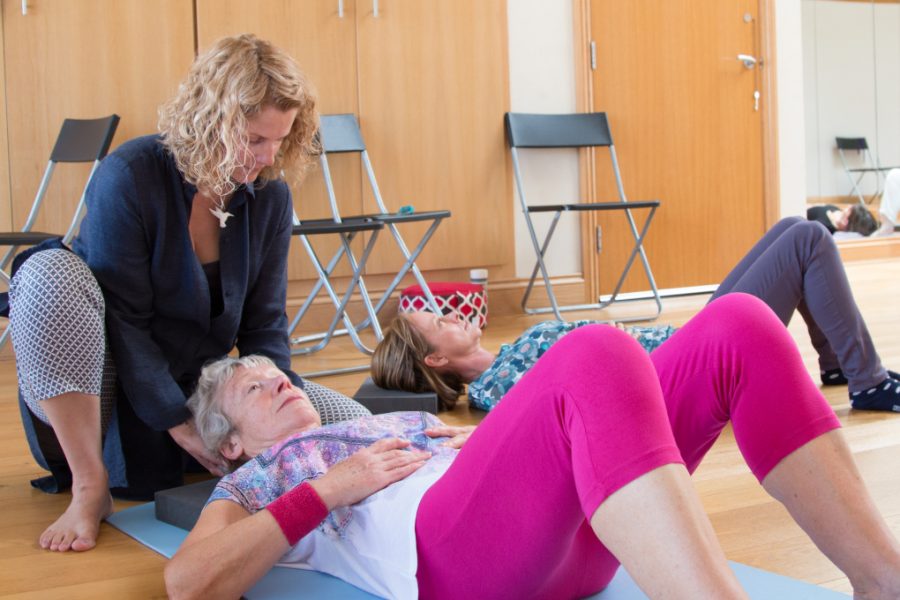Caring for the Artist by Kirstie Richardson
Who cares about ‘Taking Care’ – thoughts on dancers working within health settings.
As I laid in bed with a pulled muscle, kicking myself because I should have known better, I felt propelled to write down my thoughts about a subject I have been on my soapbox about for over a decade: Recognising in myself that even knowing all this stuff around self-care, I choose at times to press the override button and ignore my very own advice!
Having taught dance and movement for 30 years in a variety of settings with a wide demographic of people, ages, ability and health, I am astounded by mine and others shortcomings when it comes to taking care of oneself. A dancer is a highly skilled individual who is naturally capable of working in a variety of settings especially if they are free-lance and work within the community. Self-reliant, self-disciplined, self-motivated, self-managing, weaving their way through a range of opportunities and often saying YES to too many things. Perhaps a teacher, performer, administrator, mother, entertainer, wardrobe mistress, waiter, and receptionist -the list of the dancing juggler is endless.
So it is here that my concerns begin: Why don’t we take better care of ourselves? Well, the obvious answer is most freelancers are trying to make a living and also love their work. But how do we care for ourselves when working with the most vulnerable, those living with life-threatening illnesses, disability, mental health and elders, to name but a few. Dancers are amazing in such settings and offer so much in terms of their knowledge. They are passionate about their art form and believe in it and all that it offers from its playfulness to its subtle quieting of the nervous system. We know how it can enhance our living, help us embrace the moment, listen in to our deepest thoughts and feelings, guide us and support us. We have all experienced it first hand, but what do we do when we have said yes to too much, are not supported in our health settings or by colleagues and we face burn-out.
Well the most obvious thing we ‘should’ do is to start listening to our own bodies because it will be telling us in small ways, to begin with, that we are overloaded either emotionally and/or physically. Maybe the first step is more sleep and good food, which is a concrete practical solution. But this might not be enough to sustain a workload: Asking ourselves simple questions such as ‘Are you being kind to yourself?’, ‘Are you trying to please too many people’ and ‘have you got an infrastructure in place by which you feel supported?’ may serve you better.
Having taught in hospitals, hospices and mental health units for over 15 years as a freelance dance artist, I have experienced those moments when it is all too much. Thankfully through the good practice of Joe Moran and Dance Art Foundation I have learnt the importance of making sure I have supervision (a one to one session with a qualified therapist to talk about ones work) when I am working in what can sometimes be upsetting or stressful institutions. But for those who are working as out-reach artists in a community setting, boundaries and time aside for self-care becomes more tricky and is often seen as a luxury. I was struck by a conversation with a young dance artist on the brink of tears wondering why she was finding it all so hard to go from the hospice work in the morning (which incidentally the administration team thought was fantastic that she was doing such great ‘worthy’ work), and then having to go on and teach elsewhere in the afternoon. It is wonderful that dance is recognised for being so powerful in these settings but the care for those leading the workshops needs to be taken into consideration, budgeted for and supported fully.
I would suggest that mentorship and training for young freelancers is imperative before entering into any vulnerable institutions. It is crucial that a dancer knows that just because she/he/they can teach a good session in a certain setting doesn’t mean that they must. Knowing where you do and don’t feel comfortable is as important to the teacher as well as the participants.
If we feel vulnerable or afraid when we are teaching, then we are doing a disservice to those who are most vulnerable within the community. The remit for a freelance dancer is so broad that there has to be scope for specialising and saying yes to areas of connection, and no to areas that one feels de-skilled in or unable to cope with.
As I approach my 50th year I feel so supported by my dance practice – a lifelong companion which has led me down many unexpected paths, and I believe wholeheartedly as a teacher in its ability to bring joy and tenderness into other people’s lives. I am thrilled that it is being recognised so fully within health settings, and to all those wonderful dancers out there working in them. So this is a gentle reminder as I remind myself too… remember to take care.


